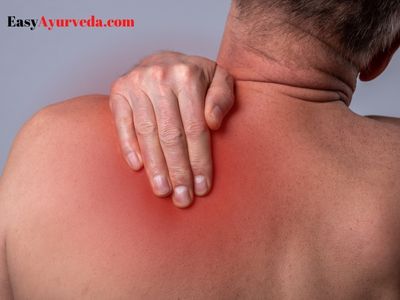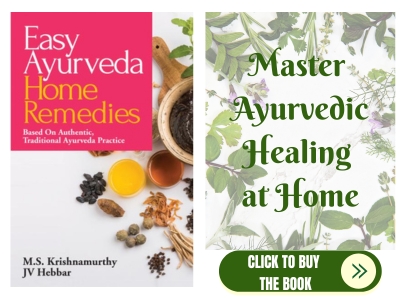Management of Blunt Injury, Inflammation with Ayurveda
Blunt injury, sprains and blunt wounds due to a fall or an accident primarily increases Vata dosha. Hence, all measures of Vata dosha balance are application in such a situation.
Table of Contents
Ice Packs
Ice packs relieve pain instantly. As per Ayurveda, pain is a cardinal sign of Vata dosha and coldness is a quality of Vata. So, coldness of ice pack should increase the pain, but it decreases. How?
Dr JV Hebbar
During an emergency situation, you would take some emergency steps by breaking some rules and once when the emergency is gone, you would restore the normal order.
Similarly, when there is a blunt injury, an ice pack is a great way to reduce the pain sensation quickly.
Read: Injury, Wound care Ayurvedic Remedies, Medicines

Ice packs bring about below-mentioned changes in the body
Vasoconstriction
Cold temperature causes local blood vessels to constrict. This decreases blood flow to the area and thus prevents development of swelling and inflammation.
In the short term, it is a good mechanism to reduce the pain. But in the long term, the swelling and inflammation is a good thing to happen, as it reminds the person not to use the painful part more and rest it. It also kickstarts the healing process.
Inflammation is a good process to happen. Inflammation attracts immune cells, such as white blood cells, to the injured area. These cells remove debris, bacteria, foreign substances from the site of injury. They help to clean the wound and prevent infection, creating a favorable environment for healing. The immune cells do these actions by releasing chemicals such as cytokines, chemokines, and prostaglandins.
Read: Classification Of Marma Based On Effect Of Injury
Decreased Nerve Conduction
Cold packs numb the area and decrease nerve conduction. Nerves carry pain signals. Because nerve endings are numbed (blocked), the pain sensation does not reach the brain.
In the short term, this is a good thing to reduce the pain sensation. But in the long term, it is good for the brain to feel the pain. Once the pain signals are received by the brain, the body makes arrangements to send healing factors, nutrients, oxygen and immunity cells to the site of injury, which kickstarts the healing process.
Read: Types Of Swelling – Ayurveda Diagnosis Charak Samhita Sutrasthan-18
Buy Charaka Samhita Text – Translated by Easy Ayurveda
Reduced Metabolic Activity: Cold therapy slows down metabolic activity and production of inflammatory chemicals. This reduces swelling and tissue damage in the short term. But we already known that in the long term, these processes are necessary for healing.
Analgesic Effect
Cold therapy can relieve pain temporarily by numbing the nerve ending and reducing inflammation. But inflammation is a good thing to happen. Inflammation helps in tissue remodeling. by activating specialized cells called fibroblasts.
Fibroblasts produce collagen, a key component of connective tissue, which helps to repair and strengthen the damaged area. Collagen forms a framework for the healing process and supports the regeneration of new tissue.
Inflammation also removes dead and damaged cells from the site of injury.
Read: Shotha (inflammation): Causes, Types, Treatment, Medicines
Cooling Effect
The cold temperature distracts the brain from the pain, temporarily.
It’s important to note that cold packs should be used with great caution and only for a short duration of 15-20 minutes with breaks in between.
Avoid direct skin contact of ice. Use a towel or cloth for preparing a cold pack.
The bottom line is, the pain relief effect of ice packs is temporary and it just blocks the pain rather than healing the pain.
Coming to Vata dosha, coldness quality and pain sensation, it is true that pain is a vata symptom and coldness should increase pain sensation. But in the case of ice pack application, Vata dosha is temporarily blocked by the ice on skin, thus the sensation of pain is also blocked for a short period of time.
In the long run, coldness increases pain due to Vata dosha increase.
Eg: Joint pains worsen during winter.
Read: Cold Quality – Sheeta Meaning, Action On Doshas, Therapeutic Uses
Applying Oil
In case of a blunt injury / sprain, after applying an ice pack, is it wise to apply Ayurvedic pain relieving oils such as Mahanarayana taila?
Ice packs numb the nerves of the area, thus reducing the pain sensation. But ice packs are not to be applied for longer than 10-20 minutes. Soon after you remove the ice pack, it is not a good idea to apply Ayurvedic oils directly. Coldness and oiliness are two qualities which should not be mixed, during the event of inflammation. It blocks the channels, delays opening up of local blood pipes (vasodilation) and thus, delays the flow of immune cells to the area for the clean up work.
After removing the ice pack, gently wipe the area dry and wait for a few minutes for the local temperature on the injured area to normalize. Once the temperature is normal, gently apply Ayurvedic pain relieving oil.
A few conditions apply.
1. Check for any open wounds. If open wounds (as in road traffic accidents), applying some oils like Karpooradi taila may increase bleeding tendency. Hence, we are exclusively talking about blunt injury here, as in case of fall leading to a sprained leg or bump on the
forehead.
2. No sweating / steam therapy. Usually after oil massage, hot fomentation is advised. This helps in relaxing the muscles and aids in better absorption of applied oil. But here, sweating therapy / local fomentation or steam is not required. This may aggravate Pitta dosha and cause worsening of pain and swelling.
3. After applying the oil, if there are no fractures, then a semi-tight bandage applied locally helps to keep the pain under check.
4. The oil should be applied gently and no pressure should be applied over it.
5. If you are applying any oil on your forehead, then care should be taken to avoid eye exposure.
6. Some Vaidyas may mix more than one oil, but this is generally not a necessity in most of the cases.
Good oils to apply after a twist, sprain or blunt injury:
Mahanarayana oil– Suits most of the conditions. Can be considered the default oil to apply
Dhanwantaram thailam – If there is stiffness along with pain
Murivenna oil – Most preferred oil, also applied in case of hairline fracture and traditional fracture healing bandages
Kottamchukkadi taila– If local warmth is desired. Contains ginger, hence the oil keeps the local area warm.
Mahamasha taila– If the local area requires nourishment. For example, a very weak person having constant pain with muscle weakness.
Balaswagandhadi taila / Ashwagandha Bala Lakshadi taila – When the injury involves nerve, muscle and bone damage
Ksheerabala taila – When there is neurological pain and nerve damage.
Herbal Pastes
Ayurveda explains a special type of creams prepared from pastes of herbs called “Lepa”
Below herbal pastes are often applied over the afflicted swollen areas. Few examples are –
Nagaradi Lepa – Contains mainly ginger and aloe vera
SKM Mahanarayana Thaila Lepam – Contains Rasna, camphor, turmeric and Shatavari
Manikkunthirikkadi Lepa Choornam – Contains Shallaki, Vacha, ginger, Bola, Aloevera, Sarjarasa (very similar ingredients to Nagaradi Lepa)
Shothaghna Lepa – Contains Punarnava, Devadaru, Shunti, mustard.
Dashang Lep – Contains Shirisha, Licorice, Indian Valerian root, Sandalwood, cardamom, Jatamansi, turmeric, tree turmeric etc.
Home remedies for swelling
A mix of below herbs, as available, can be made into paste and applied locally to relieve pain.
1. Take Mahanarayana oil – 100 ml.
To it, add a mix of equal parts of below herbs. You can do the paste just with a few herbs. Not all are required together.
ginger, Sallaki, Guggulu gum, Rasna, Aloe vera, Myrrh, turmeric, Laksha, Devadaru, licorice, sandalwood, cardamom, jatamansi, Sarjarasa.
Ayurvedic Medicines
The below medicines are useful to relieve pain and inflammation quickly
Rasnadi kashayam / tablet
Maharasnadi Kashayam / tablet
Sallaki tablet
Yogaraja Guggulu
Mahayogaraja Guggulu
Rasnadi Guggulu
Dashamoola kashayam / tablet
Ksheerabala 101 capsule
Dhanwantharam 101 capsule
Ashtavargam kashayam / kwatham tablet
Bala Guluchyadi Kashayam
Dhanwantharam kwatham
Guggulu tiktakam, Nimbamritadi Panchatiktam – Especially when there is underlying infection / pus formation
Sahacharadi kashayam
Varanadi kwatham tablet – Useful in water retention and fluid collection
Kaishora Guggulu, Yashtimadhu Ghrita, Maha Manjishtadi Kashayam, Manjishtadi tailam – in case of vascular injury









